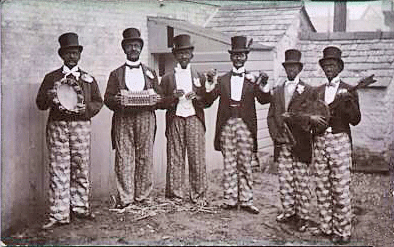Annotation:Jim Crow: Difference between revisions
No edit summary |
No edit summary |
||
| (One intermediate revision by the same user not shown) | |||
| Line 2: | Line 2: | ||
{{TuneAnnotation | {{TuneAnnotation | ||
|f_tune_annotation_title=https://tunearch.org/wiki/Annotation:Jim_Crow > | |f_tune_annotation_title=https://tunearch.org/wiki/Annotation:Jim_Crow > | ||
|f_annotation='''JIM CROW'''. AKA | |f_annotation='''JIM CROW'''. AKA and see "[[Jim Crow Quadrille (5)]]," "[[Jump Jim Crow]]." American, Song Tune. D Major. Standard tuning (fiddle). ABC. "Jim Crow" song popularized on the minstrel stage of the mid-19th century. "Jim Crow" (and "Jim Crow Polka") were printed in an early surviving collection of minstrel music, '''The Complete Preceptor for the Banjo''' (1848), by 'Gumbo Chaff', a pseudonym for Boston publisher Elias Howe, and even earlier in Howe's '''Second Part of the Musician's Companion''' (1943). Howe sold the rights to the collection and others of his works to another Boston publisher, Oliver Dixon (who issued the Chaff tutor in 1851) on the condition that Howe refrain from publishing similar works for ten years. Dave Evans remarks on the similarity of the title "Jim Crow" to "John Crow," a folk name for a buzzard, and suggests that the "Jim Crow" song and dance is perhaps derived from the slave dance "The Buzzard Lope" (see Parish, '''Slave Songs of the Georgia Sea Islands''', 1942). See also the Appalachian fiddle tune derivative "[[Annotation:Jump Jim Crow]]." | ||
[[File:blackface.png|500px|thumb|left|Blackface minstrel troupe, c. 1875]] | [[File:blackface.png|500px|thumb|left|Blackface minstrel troupe, c. 1875]] | ||
<blockquote> | <blockquote> | ||
| Line 15: | Line 15: | ||
''You jump Jim Crow.'' .... (Scarborough, '''On the Trail''')<br> | ''You jump Jim Crow.'' .... (Scarborough, '''On the Trail''')<br> | ||
</blockquote> | </blockquote> | ||
The popular melody was imported to England and, as were other minstrel tunes, was absorbed into traditional repertoire, where it appears in musicians manuscripts of the mid-19th century. | The popular melody was imported to England and, as were other minstrel tunes, was absorbed into traditional repertoire, where it appears in musicians manuscripts of the mid-19th century. It can be found, for example in the 1850 music manuscript collections of shoemaker and fiddler William Winter, of Bagborough, Somerset, southwest England, and Eliza Hancock, of Wiveliscombe, Somerset. | ||
|f_source_for_notated_version= | |f_source_for_notated_version= | ||
|f_printed_sources=Gumbo Chaff ('''The Complete Preceptor for the Banjo'''), 1851; p. 7. Ford ('''Traditional Music in America'''), 1940; p. 83 (additional lyrics on p. 424). Elias Howe ('''Second Part of the Musician’s Companion'''), 1843; p. 57. | |f_printed_sources=Gumbo Chaff ('''The Complete Preceptor for the Banjo'''), 1851; p. 7. Ford ('''Traditional Music in America'''), 1940; p. 83 (additional lyrics on p. 424). Elias Howe ('''Second Part of the Musician’s Companion'''), 1843; p. 57. Geoff Woolfe ('''William Winter's Quantocks Tune Book'''), 2007; No. 283, p. 103. | ||
|f_recorded_sources= | |f_recorded_sources= | ||
|f_see_also_listing=Jane Keefer's Folk Music Index: An Index to Recorded Sources [http://www.ibiblio.org/keefer/j07.htm#Jumjicr]<Br> | |f_see_also_listing=Jane Keefer's Folk Music Index: An Index to Recorded Sources [http://www.ibiblio.org/keefer/j07.htm#Jumjicr]<Br> | ||
}} | }} | ||
------------- | ------------- | ||
Latest revision as of 16:28, 22 March 2024
X:1 T:Jim Crow M:2/4 L:1/8 R:Minstrel tune B:Elias Howe – Second Part of the Musician’s Companion (1843, p. 57) Z:AK/Fiddler’s Companion K:G g|f/>d/d/>d/ f/>a/a/>f/|g/f/e/f/ gz/g/|f/g/e/f/ d/e/f/d/|A/B/A/F/ GF/G/| AF/A/ BG/B/|c/B/A/B/ c2|B/c/d/B/ c/d/e/c/|dfg:| K:C g/=f/|e/f/g/e/ f/g/a/f/|e/f/g/e/ d/B/A/G/|e/d/e/c/ f/g/a/f/|e/c/d/B/ cg/f/| e/f/g/e/ f/g/a/f/|e/f/g/e/ d/B/A/G/|e/d/e/c/ f/g/a/f/|e/c/d/B/ c!D.C.!||
JIM CROW. AKA and see "Jim Crow Quadrille (5)," "Jump Jim Crow." American, Song Tune. D Major. Standard tuning (fiddle). ABC. "Jim Crow" song popularized on the minstrel stage of the mid-19th century. "Jim Crow" (and "Jim Crow Polka") were printed in an early surviving collection of minstrel music, The Complete Preceptor for the Banjo (1848), by 'Gumbo Chaff', a pseudonym for Boston publisher Elias Howe, and even earlier in Howe's Second Part of the Musician's Companion (1943). Howe sold the rights to the collection and others of his works to another Boston publisher, Oliver Dixon (who issued the Chaff tutor in 1851) on the condition that Howe refrain from publishing similar works for ten years. Dave Evans remarks on the similarity of the title "Jim Crow" to "John Crow," a folk name for a buzzard, and suggests that the "Jim Crow" song and dance is perhaps derived from the slave dance "The Buzzard Lope" (see Parish, Slave Songs of the Georgia Sea Islands, 1942). See also the Appalachian fiddle tune derivative "Annotation:Jump Jim Crow."

Come, listen all you gals and boys,
I'm just from Tuckyhoe.
I'm goin' to sing a little song,
My name's Jim Crow. .... (Ford)
Turn about and twist about,
And do jes' so
An' every time you turn about
You jump Jim Crow. .... (Scarborough, On the Trail)
The popular melody was imported to England and, as were other minstrel tunes, was absorbed into traditional repertoire, where it appears in musicians manuscripts of the mid-19th century. It can be found, for example in the 1850 music manuscript collections of shoemaker and fiddler William Winter, of Bagborough, Somerset, southwest England, and Eliza Hancock, of Wiveliscombe, Somerset.

